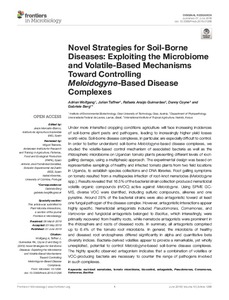| dc.contributor.author | Wolfgang, A. |
| dc.contributor.author | Taffner, J. |
| dc.contributor.author | Guimarães, R.A. |
| dc.contributor.author | Coyne, D. |
| dc.contributor.author | Berg. G. |
| dc.date.accessioned | 2019-12-04T11:33:57Z |
| dc.date.available | 2019-12-04T11:33:57Z |
| dc.date.issued | 2019-06-07 |
| dc.identifier.citation | Wolfgang, A., Taffner, J., Guimarães, R.A., Coyne, D. & Berg, G. (2019). Novel strategies for soil-borne diseases: exploiting the microbiome and volatile-based mechanisms towards controlling Meloidogyne-based disease complexes. Frontiers in Microbiology, 10: 1296, 1-15. |
| dc.identifier.issn | 1664-302X |
| dc.identifier.uri | https://hdl.handle.net/20.500.12478/5853 |
| dc.description | Open Access Journal |
| dc.description.abstract | Under more intensified cropping conditions agriculture will face increasing incidences of soil-borne plant pests and pathogens, leading to increasingly higher yield losses world-wide. Soil-borne disease complexes, in particular, are especially difficult to control. In order to better understand soil-borne Meloidogyne-based disease complexes, we studied the volatile-based control mechanism of associated bacteria as well as the rhizospheric microbiome on Ugandan tomato plants presenting different levels of root-galling damage, using a multiphasic approach. The experimental design was based on representative samplings of healthy and infected tomato plants from two field locations in Uganda, to establish species collections and DNA libraries. Root galling symptoms on tomato resulted from a multispecies infection of root-knot nematodes (Meloidogyne spp.). Results revealed that 16.5% of the bacterial strain collection produced nematicidal volatile organic compounds (nVOC) active against Meloidogyne. Using SPME GC-MS, diverse VOC were identified, including sulfuric compounds, alkenes and one pyrazine. Around 28% of the bacterial strains were also antagonistic toward at least one fungal pathogen of the disease complex. However, antagonistic interactions appear highly specific. Nematicidal antagonists included Pseudomonas, Comamonas, and Variovorax and fungicidal antagonists belonged to Bacillus, which interestingly, were primarily recovered from healthy roots, while nematode antagonists were prominent in the rhizosphere and roots of diseased roots. In summary, all antagonists comprised up to 6.4% of the tomato root microbiota. In general, the microbiota of healthy and diseased root endospheres differed significantly in alpha and quantitative beta diversity indices. Bacteria-derived volatiles appear to provide a remarkable, yet wholly unexploited, potential to control Meloidogyne-based soil-borne disease complexes. The highly specific observed antagonism indicates that a combination of volatiles or VOC-producing bacteria are necessary to counter the range of pathogens involved in such complexes. |
| dc.description.sponsorship | Austrian Development Agency |
| dc.format.extent | 1-15 |
| dc.language.iso | en |
| dc.rights | CC-BY-4.0 |
| dc.subject | Root Knot Nematodes |
| dc.subject | Biocontrol |
| dc.subject | Pseudomonas |
| dc.subject | Bacillus |
| dc.subject | Solanum Lycopersicum |
| dc.subject | Tomatoes |
| dc.subject | Meloidogyne |
| dc.title | Novel strategies for soil-borne diseases: exploiting the Microbiome and volatile-based mechanisms toward controlling Meloidogyne-based disease complexes |
| dc.type | Journal Article |
| dc.description.version | Peer Review |
| cg.contributor.crp | Roots, Tubers and Bananas |
| cg.coverage.region | Africa |
| cg.coverage.region | East Africa |
| cg.coverage.country | Uganda |
| cg.creator.identifier | Daniel Coyne: 0000-0002-2030-6328 |
| cg.researchtheme | NATURAL RESOURCE MANAGEMENT |
| cg.isijournal | ISI Journal |
| cg.authorship.types | CGIAR and developing country institute |
| cg.iitasubject | Disease Control |
| cg.iitasubject | Natural Resource Management |
| cg.journal | Frontiers in Microbiology |
| cg.howpublished | Formally Published |
| cg.accessibilitystatus | Open Access |
| local.dspaceid | 105569 |
| cg.targetaudience | Scientists |
| cg.identifier.doi | https://dx.doi.org/10.3389/fmicb.2019.01296 |

